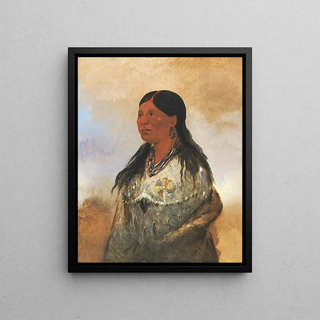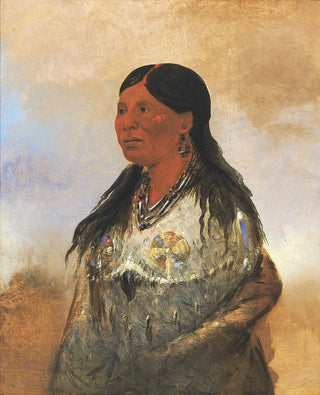Painting Hnjeapto Wife of Bearcatcher - George Catlin | Art print


View from behind

Frame (optional)
In the vibrant world of 19th-century American art, the "Hnjeapto Épouse de Bearcatcher" by George Catlin stands out for its profound commitment to representing Native American cultures. This artwork, both portrait and testimony, immerses us in the intimacy of an iconic figure, Hnjeapto, a woman who embodies the richness of indigenous traditions and customs. Through this painting, Catlin does not merely capture the physical appearance of his subject; he also evokes the very essence of her identity, offering a window into a world often misunderstood and endangered. The art print of this piece is much more than a simple replica; it is a tribute to the memory and culture of the nations of America.
Style and uniqueness of the artwork
George Catlin's style is characterized by a realistic approach, yet tinged with a romantic sensitivity that allows him to transcend mere visual recording. In "Hnjeapto Épouse de Bearcatcher," vibrant colors and meticulous details combine to create an atmosphere that is both lively and contemplative. Catlin uses striking contrasts to highlight the features of his subject, while incorporating symbolic elements that reinforce the message of the piece. The traditional ornaments adorning Hnjeapto's attire, for example, are not just accessories but powerful symbols of her cultural heritage. This painting demonstrates a unique sensitivity to the beauty of Native American cultures, while subtly critiquing the stereotypes surrounding them. In this way, it goes beyond a simple representation to become a visual manifesto advocating for the recognition and respect of cultural identities.
The artist and his influence
George Catlin, often regarded as the first painter to document Native American tribes, dedicated a significant part of his life to preserving their memory through his art. His artistic journey is marked by a deep passion for the cultures he encountered during his travels across the United States. Catlin was not only an observer but also a passionate advocate

Matte finish

View from behind

Frame (optional)
In the vibrant world of 19th-century American art, the "Hnjeapto Épouse de Bearcatcher" by George Catlin stands out for its profound commitment to representing Native American cultures. This artwork, both portrait and testimony, immerses us in the intimacy of an iconic figure, Hnjeapto, a woman who embodies the richness of indigenous traditions and customs. Through this painting, Catlin does not merely capture the physical appearance of his subject; he also evokes the very essence of her identity, offering a window into a world often misunderstood and endangered. The art print of this piece is much more than a simple replica; it is a tribute to the memory and culture of the nations of America.
Style and uniqueness of the artwork
George Catlin's style is characterized by a realistic approach, yet tinged with a romantic sensitivity that allows him to transcend mere visual recording. In "Hnjeapto Épouse de Bearcatcher," vibrant colors and meticulous details combine to create an atmosphere that is both lively and contemplative. Catlin uses striking contrasts to highlight the features of his subject, while incorporating symbolic elements that reinforce the message of the piece. The traditional ornaments adorning Hnjeapto's attire, for example, are not just accessories but powerful symbols of her cultural heritage. This painting demonstrates a unique sensitivity to the beauty of Native American cultures, while subtly critiquing the stereotypes surrounding them. In this way, it goes beyond a simple representation to become a visual manifesto advocating for the recognition and respect of cultural identities.
The artist and his influence
George Catlin, often regarded as the first painter to document Native American tribes, dedicated a significant part of his life to preserving their memory through his art. His artistic journey is marked by a deep passion for the cultures he encountered during his travels across the United States. Catlin was not only an observer but also a passionate advocate
12,34 €






